![]()

 |
 |
 |
 |
 |
Rhythm of cobblestones
By G-mi K.

Wandering on the paved cobblestones, have you ever noticed the interesting decorative patterns underfoot? Colored in cream, black and sometimes caramel or red, Portuguese pavements have gradually become a local cultural identity and name card.
From Lisbon to Macao
It is said that in the late 15th Century, King Manuel I of Portugal ordered to create a brand new pavement Lisbon for his birthday parade. After the 1755 Lisbon earthquake, people adapted the paving technique with wreckage to rebuild the city’s streets. Some pioneer artistic trials took place in the 19th Century, in places such as the Saint George's Castle and the Rossio Square in Lisbon. Since then, the Roman mosaic-like pavement was spread throughout Portugal and its colonies, though cobblestones were not initially used.
In Macao, numerous pavement’s predecessors were seen centuries ago. Portuguese trade ships brought limestones and basalts to its former colony, due to a need of weight control for sailing. However, the modern Portuguese pavement, for decoration purpose, was not yet seen in Macao until 1992, when the Bela Vista Hotel paved its terrace. The colonial government started paving the territory’s central area a year after. This tradition continued after the Handover in 1999 with the SAR government. More streets and public places were then paved in the past two decades.
Apart from this, localization was also considered. This can be seen from the increasing uses of red stones, which were rarely seen elsewhere. It is said that the red ones absorb heat, are less reflective, and are welcomed by the Chinese population – the color represents happiness, prosperity and longevity.
Framing the beauties
Some streets are simply covered with irregularly-shaped cobblestones, while some are well-designed and paved with themed textures and patterns. They have made the neighborhoods’ streets no more monotonous, but instead, artistically lovely.
Senado Square: Thanks to the cobblestones introduced in 1993, today, the busy, crowded district is seen as the city’s premier landmark. Beside the large waves in the pavement pattern, clipart of churches, temples and Ruins of St Paul's façade are also laid out. They actually show directions, which lead people to these cultural heritage sites nearby.
Avenida de Almeida Ribeiro: The pavement on Av. Almeida Ribeiro was designed by architect Francisco Vizeu Pinheiro in 2001. According to an article from magazine Macau, his team integrated feng shui concepts into the maritime-themed design, of the avenue ending at Inner Harbor.
The article introduced that gaming-related ideas in local culture, such as the fish-prawn-crab sequence (literally means Yee Hah Hi, a dice game), were also presented on the pavement.
Largo da Sé: Paved with fish and ovals in 2004, it is said that the area is themed with the Bible story “Loaves and Fish”. The ship pattern with “duc in altum (put out into the deep)” underneath, also came from the Bible.
Luís Vaz de Camões Garden: 10 big mosaic paintings regarding 10 cantos of the Lusiads, Portugal's national epic composed here by Luís Vaz de Camões, are paved in this legendary garden in 1996. They represent the legendary stories of the Portuguese voyages of discovery, during the 15th and 16th centuries.
Praia Grande/S. Francisco Garden: A compass was paved in 2005, showing the presence of the former Praia Grande (Big Bay).
In front of Colegio de Santa Rosa De Lima (Chinese Section), there is also a symbol of Franciscan Missionaries of Mary, the school’s sponsoring body.
Travessa dos Anjos: Completed in 2013, the lane is paved with flower and butterfly patterns. The two symbols represent beauty and harmony. However, an article from Macau, which attributed the source of the Civic and Municipal Affairs Bureau, revealed that angel patterns and zodiac signs were once preferred but later replaced for neutrality.
NAPE/Kun Iam Ecumenical Centre: Finished in 1999, the pavement features Chinese religious elements, such as the yin-yang symbol. This is a remarkably indigenized use of cobblestones in the city.
St. Lawrence Parish/Barra neighborhood: Maritime and colonial symbols. Cobblestones in this area are paved in circle blocks. One interesting pair of pattern found here is the junk and the carrack - the traditional Chinese and European ships - on both sides of the road.
Barra Square/A-ma Temple: The plaza is paved in 1997. A massive use of red stones was seen. As previously introduced, red is a positive color in Chinese culture. The pavement symbolizes a perfect Sino-Luso representation.
University of Macau: Despite the plainly -designed, awkwardly-paved cobblestones on the Central Avenue and the yard in E3x buildings, the university’s new campus exhibits some patterned cobblestone designs. For example, the theme elements taken from the university’s emblem, are paved on the Library Plaza.
Other notable pavements: Tap Seac, St. Lazarus Parish, Gate of Understanding, Taipa Village, Coloane Village.